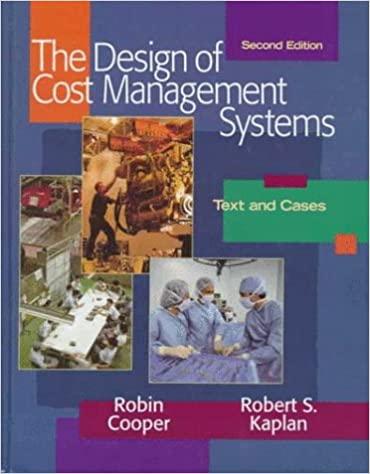Question
Ramsey Company produces speakers (Model A and Model B). Both products pass through two producing departments. Model A's production is much more labor-intensive than that
Ramsey Company produces speakers (Model A and Model B). Both products pass through two producing departments. Model A's production is much more labor-intensive than that of Model B. Model B is also the more popular of the two speakers. The following data has been gathered for the two products: Product Data Model A Model B Units produced per year 10,000 100,000 Prime costs $150,000 $1,500,000 Direct labor hours 140,000 300,000 Machine hours 20,000 200,000 Production runs 40 60 Inspection hours 800 1,200 Maintenance hours 10,000 90,000 Overhead costs: Setup costs $270,000 Inspection costs 210,000 Machining
Ramsey Company produces speakers (Model A and Model B). Both products pass through two producing departments. Model A's production is much more labor-intensive than that of Model B. Model B is also the more popular of the two speakers. The following data has been gathered for the two products:
| Product Data | ||
| Model A | Model B | |
| Units produced per year | 10,000 | 100,000 |
| Prime costs | $150,000 | $1,500,000 |
| Direct labor hours | 140,000 | 300,000 |
| Machine hours | 20,000 | 200,000 |
| Production runs | 40 | 60 |
| Inspection hours | 800 | 1,200 |
| Maintenance hours | 10,000 | 90,000 |
| Overhead costs: | ||
| Setup costs | $270,000 | |
| Inspection costs | 210,000 | |
| Machining | 240,000 | |
| Maintenance | 270,000 | |
| Total | $990,000 | |
| Required: | |
| 1. | Compute the overhead cost per unit for each product by using a plantwide rate based on direct labor hours. (Round to two decimal places.) |
| 2. | Compute the overhead cost per unit for each product by using ABC. (Round rates and unit overhead cost to two decimal places.) |
| 3. | Suppose that Ramsey decides to use departmental overhead rates. There are two departments: Department 1 (machine intensive) with a rate of $3.50 per machine hour and Department 2 (labor intensive) with a rate of $0.90 per direct labor hour. The consumption of these two drivers is as follows: |
| Department 1 | Department 2 | |
| Machine Hours | Direct Labor Hours | |
| Model A | 10,000 | 130,000 |
| Model B | 170,000 | 270,000 |
| Compute the overhead cost per unit for each product by using departmental rates. (Round to two decimal places.) | |
| 4. | CONCEPTUAL CONNECTION Using the activity-based product costs as the standard, comment on the ability of departmental rates to improve the accuracy of product costing. Did the departmental rates do better than the plantwide rate? |
Step by Step Solution
There are 3 Steps involved in it
Step: 1

Get Instant Access to Expert-Tailored Solutions
See step-by-step solutions with expert insights and AI powered tools for academic success
Step: 2

Step: 3

Ace Your Homework with AI
Get the answers you need in no time with our AI-driven, step-by-step assistance
Get Started


